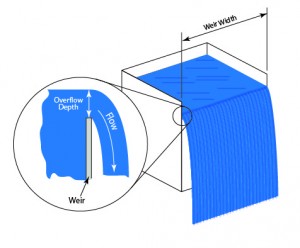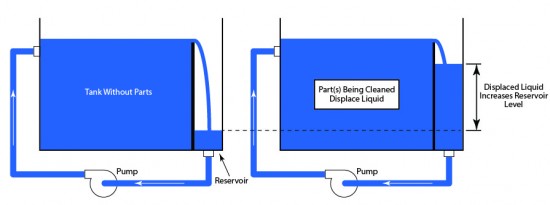Overflow weirs are common features of industrial cleaning systems. Simply, a weir is much like a dam that holds back a river to form a lake. In the case of a cleaning system, the “lake” is usually a tank of liquid. The “dam” is formed as a portion of the lip of the tank is set at a lower level than the rest to allow liquid to overflow.

When the liquid level in the tank exceeds that of the weir, liquid overflows the weir. The flow is directly proportional to W (the weir width) provided that the overflow depth is maintained the same. The volume of flow as the overflow depth changes is described by the following formula – –
F = CW√(gH³) or dimensionally speaking, x³/s = x√((x/s²)(x³))
where F is the flow rate, and C is some dimensionless coefficient that will undoubtedly be there. So, if H (overflow depth) doubles,the increase in flow would increase by 2^(1.5), or about 2.828 times greater. (Thanks Yahoo Answers!)
In industrial cleaning systems, weirs perform two basic functions. The first is to establish and control liquid level in a tank or other vessel. The other is to selectively remove floating contaminants from the surface of a liquid.
In the first function, controlling level, weirs are extremely efficient and are very, very simple compared to alternative means of level control. Maintaining a relatively uniform tank depth is often important, especially in tanks with ultrasonic transducers, as the liquid depth has an effect on the efficiency and intensity of the ultrasonic field. An overflow weir performs this function without any moving parts and has the added benefit of inherently modulating or adjusting flow as required (see above) to relatively closely (although not exactly) maintain a pre-set liquid level in spite of varying incoming flow rates and other factors like the displacement of liquid due to parts being introduced into a cleaning or rinsing tank in a cleaning system.
In most cases, overflow weirs incorporate a reservoir to collect the liquid that overflows the weir for disposal, re-use or whatever.

When parts are introduced into the process tank, they displace an amount of liquid equivalent to their volume. Without an overflow weir, the liquid depth in the process tank would increase. With an overflow weir and a recirculation pump as shown in the above illustration, the liquid level is maintained when parts are introduced and returns to the optimum level once parts are removed. This, of course, means that the overflow weir reservoir should be sized based on the volume of parts being cleaned with some additional volume to allow compensation for liquid evaporation and makeup as necessary. It is also important to establish the level of liquid in the overflow weir reservoir to accommodate the expected variations. Filling the reservoir to the same depth as the process tank will defeat its purpose.
In the next few blogs, I will discuss other functions of overflow weirs and explain some of the variations in weir designs and the logic behind them.
– FJF –



 English
English Spanish
Spanish Chinese
Chinese Canada
Canada Mexico
Mexico United Kingdom
United Kingdom



